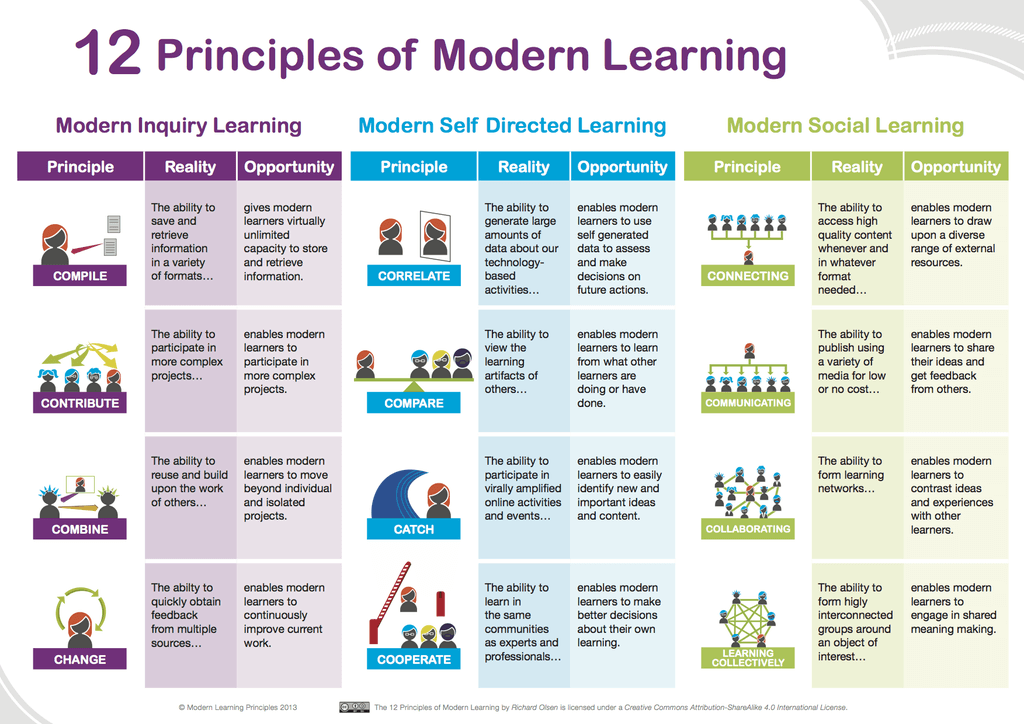

by TeachThought Staff
What are the principles of modern learning?
Well, that depends on how you define ‘learning’ and what you’d consider ‘modern.’ Richard Olsen put together this useful visual way, way back in 2013–a chart that lays out three categories of a modern approach to learning–Modern, Self-Directed, and Social.
These broad categories are then broken up into four principles per category. Each principle is then described by its Reality (its function) and Opportunity (the result of that function). Honestly, these two categories are a bit confusing–or at least the distinction between some of the entries are (the ability to participate and enables modern learners to participate, for example).
Overall, though, defining ‘modern learning’ through inquiry, self-direction, and connectivity is at the core of what we preach here at TeachThought. Let’s take a look at what it’s saying by exploring the first category, Modern Inquiry Learning.
12 Principles Of Modern Learning
The four principles of Modern Inquiry Learning, according to the graphic, are Compile, Contribute, Combine, and Change, with their respective Realities and Opportunities shown below.
Modern Inquiry Learning
Principle: Compile
Reality: The ability to save and retrieve information in a variety of formats
Opportunity: Give modern learners virtually ‘unlimited’ capacity to retrieve and store information
Principle: Contribute
Reality: The ability to participate in more complex projects
Opportunity: Enables learners to participate in more complex projects
Principle: Combine
Reality: The ability to reuse and build upon the work of others (ed note: as we are doing with this post)
Opportunity: Allows learners to move beyond individual and isolated projects
Principle: Change
Reality: The ability to quickly obtain learning feedback from multiple sources
Opportunity: Enables learners to continuously improve work
Modern Self-Directed Learning
Principle: Correlate
Reality: The ability to generate large amounts of data about our technology-based activities…
Opportunity: Enables modern learners to use self-generated data to assess and make decisions on future actions.
Principle: Compare
Reality: The ability to view the learning artifacts of others…
Opportunity: Enables modern learners to learn from what other learners are doing or have done.
Principle: Catch
Reality: The ability to participate in virally amplified online activities and events…
Opportunity: Enables modern learners to easily identify new and important ideas and content.
Cooperate
Reality: The ability to learn in the same communities as experts and professionals.
Opportunity: Enables modern learners to make better decisions about their own learning.
Modern Social Learning
Connecting
Reality: The ability to access high-quality content whenever and in whatever format needed…
Opportunity: Enables modern learners to draw upon a diverse range of external resources.
Communicating
Reality: The ability to publish using a variety of media for low or no cost…
Opportunity: Enables modern learners to share their ideas and get feedback from others.
Collaborating
Reality: The ability to form learning networks…
Opportunity: Enables modern learners to contrast ideas and experiences with other learners.
Learning Collectively
Reality: The ability to form highly interconnected groups around an object of interest…
Opportunity: Enables modern learners to engage in shared meaning-making.
Our Take
While the graphic doesn’t really get at the core values of what makes each approach (Inquiry, Self-Direction, Connectivity) valuable and worthwhile (and so misses a huge opportunity), the trifecta of the three does, in fact, represent prevailing movements in progressive education. Technology, for example, would be a part of each. It supports inquiry and self-direction while being both a cause and effect of connectivity.
How should you use this to guide your teaching? You could take the verbs shown here (e.g., contribute, correlate, etc.) and design project-based learning or related learning playlist activities alongside your students.
12 Principles Of Modern Learning; image attribution Richard Olsen